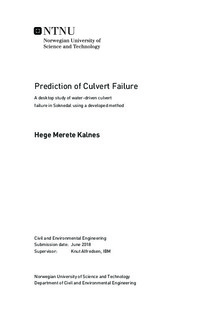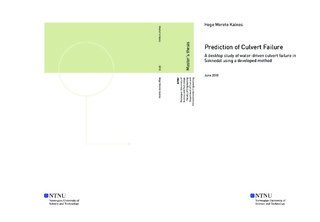| dc.description.abstract | The risk connected to water-related hazards on roads and railways is becoming more acute in Norway. A significant maintenance backlog combined with climate change and land modification and -intervention has increased the probability for such events to occur, and the importance of the road- and railway infrastructure is increasing with a growing Norwegian economy. This work focuses on the hazard connected to water-driven culvert failure, and is a part of the research center Klima 2050 s endeavor to achieve better risk estimation for stormwater management in small catchments.
The main objective of this work is to develop a method to predict culvert failure. Failure is defined in the work as exceedance of the capacity given by the headwater that is considered safe. The method is based on using a constructed fault tree and estimates the failure occurrence from flood return periods. It is aimed to be practically applicable for risk assessments and feasible as a desktop study, primarily using available information from public Norwegian databanks and services. It is found that methods chosen to estimate capacity and flood has to be of low complexity to achieve the aim of practicality. Three simple methods are used to estimate capacity, the NIFS-formula is used to estimate flood return periods and the effects of climate- and land cover change is considered through using constant percentages of change in flood size.
Three scientific questions are established in order to provide a reference point in the development of the method and to explore its capabilities as a desktop study for risk assessments. They deal with how often culvert failure occurs under possible failure modes, the effects of climate- and land cover change on the occurrence, and how it can be reduced to an acceptable level. In answering the questions and testing the method which is developed, the work provides a case study of eight culverts in Soknedal which have previously failed and led to damages on a railway line. The findings show that the culverts will not fail unless they are severely blocked. This can occur due to slides, which are relatively common in Soknedal, or if the maintenance is inadequate.
The uncertainties in the risk estimation provided by the method are potentially large and need to be further investigated. Independently of whether the method is deemed useful and the uncertainties acceptable, this work provides a comprehensive overview of the risk connected to culverts and how it can possibly be modelled. | |

